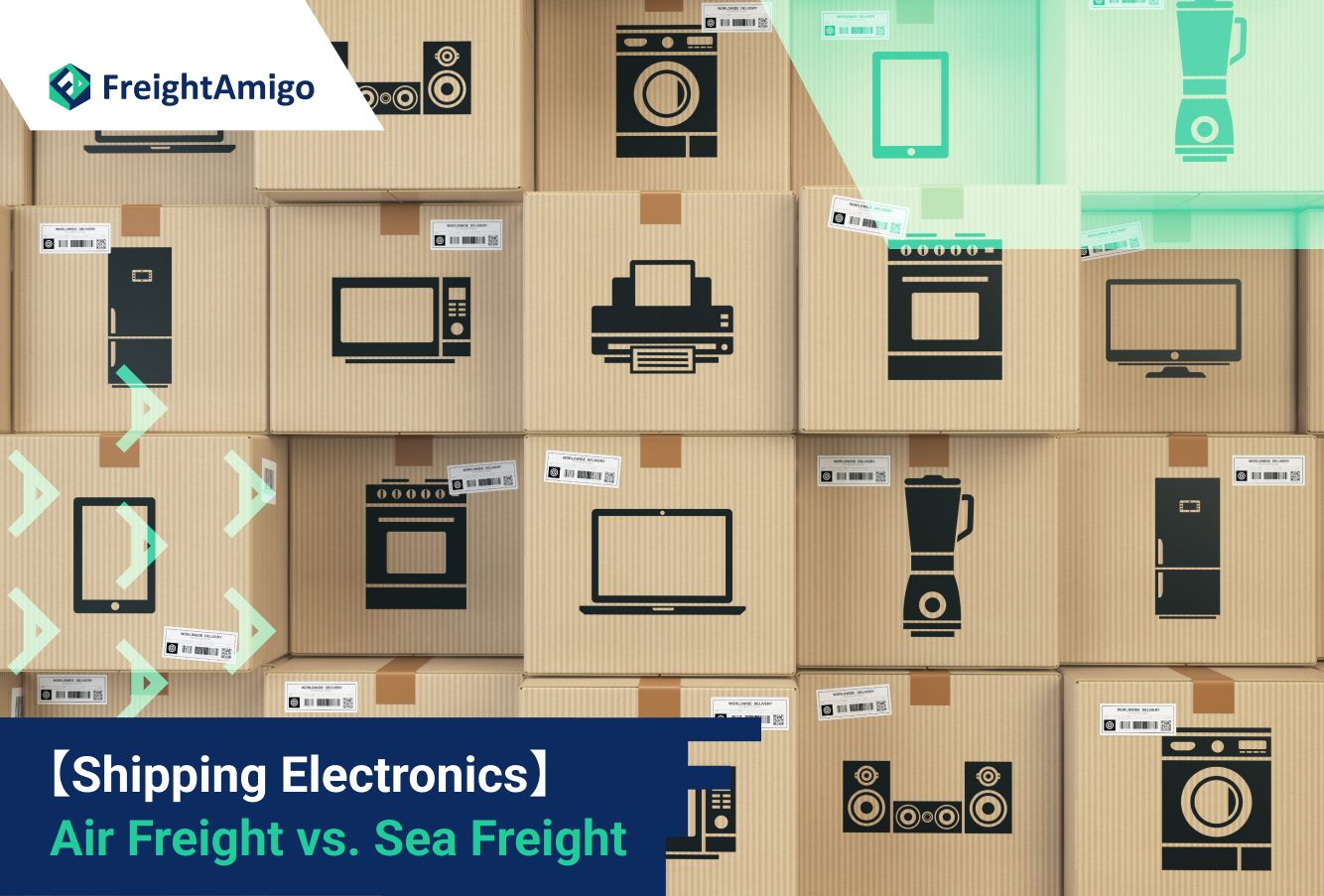Author Name: Tiffany Lee – Marketing Analyst at FreightAmigo
In today’s globalized world, shipping electronics has become a crucial part of business operations. Whether it’s consumer electronics, computer components, or high-tech gadgets, getting these products from manufacturers to consumers requires careful consideration of logistics and transportation. One of the key decisions that shippers and forwarders face is whether to use air freight or sea freight. Each mode of transportation has its own advantages and considerations, and finding the optimal choice requires a thorough analysis of factors like cost, speed, convenience, cargo safety, and accessibility.
Want To Compare The Best Express, Air Freight, Sea Freight, Rail Freight & Trucking Rates So As To Have Better Control On Cost?
The Distance Factor
When it comes to shipping electronics, the distance between the origin and the destination plays a significant role in determining the choice between air and sea freight. Air freight is most suitable for direct city-to-city transport and on the most direct routes between countries. With advances in air freight movement, it has become the preferred mode of transport for retail goods that need to reach their destination quickly. Air freight dramatically reduces the distance between two points, making it ideal for time-sensitive shipments.
On the other hand, sea freight is preferred for shipments that need to travel great distances spanning vast oceans. While sea freight may have longer transit times compared to air freight, it is a cost-effective option for transporting electronics over long distances. The further the distance, the more advantageous sea freight becomes in terms of cost efficiency.
Type of Cargo Considerations
The type of cargo being shipped is another crucial factor to consider when choosing between air and sea freight for shipping electronics. Air freight is somewhat limited in the type of cargo it can carry due to capacity, weight, and safety factors. It is primarily used for the transport of unitized cargoes. However, there are exceptions where entire flights are chartered to carry cargo for a single project. For extreme projects, shippers can even utilize the largest airplane in the world, the Antonov An-225 Mriya, which can carry up to 250 tons of cargo.
Sea freight, on the other hand, offers an absolute advantage in terms of cargo versatility. It can accommodate any type of goods in containers, making it the preferred choice for shipping electronics that may have unique packaging requirements or specific handling considerations.
Time Sensitivity: Speed vs. Transit Time
Time sensitivity is often a critical factor in the decision-making process for shipping electronics. Air freight is chosen mainly due to its quick transit times and reliable scheduled arrival and departure times. Even if it involves transshipments, an air freight shipment will generally arrive at the destination ahead of a sea freight shipment. With extensive network offerings and alliances, air freight helps shippers export or import their cargo anywhere in the world. This speed advantage can be beneficial for time-sensitive shipments, allowing businesses to reduce inventory carrying costs and capture market share.
On the other hand, not all cargo is time-sensitive and needs to reach the customer immediately. Sea freight offers cost benefits for shipments with longer transit times. While it may take a month or more for a sea freight shipment to reach its destination, many customers can plan their shipments on sea freight and still ensure just-in-time deliveries. Automotive and consumer goods businesses often utilize sea freight for its cost-effectiveness and the ability to synchronize supply chain operations.
Cost Consideration: Air Freight vs. Sea Freight
Cost is a significant consideration when it comes to shipping electronics. Air freight is known for its high cost compared to sea freight. This price difference primarily stems from the limited capacity of airplanes, higher fuel consumption, and operational costs. Air freight is generally more expensive for larger volumes of cargo due to weight considerations.
Sea freight, on the other hand, offers a substantial cost advantage for shipping electronics, especially for larger shipments. The volume of cargo a ship can carry at once, compared to an aircraft, makes sea freight much cheaper. However, it’s important to consider additional costs associated with sea freight, such as warehousing fees and potential congestion at ports, which may result in demurrage and detention charges.
Cargo Safety: Minimizing Risk
Ensuring the safety of electronics during transportation is crucial for both shippers and customers. Air freight involves minimal handling, reducing the risk of damaged cargo and increasing the chances of reaching the destination safely. Airports have strict regulations governing the storage, handling, and securing of cargo, adding an extra layer of protection.
Sea freight, while generally safe for transporting goods, requires careful packaging and securing of cargo within containers. If the cargo inside the container is not packed correctly, there is a higher possibility of damage during transit. It’s essential to ensure proper packaging and consider factors like temperature control and shock absorption to minimize the risk of cargo damage.
Accessibility: Port Congestion and Market Reach
Accessibility to transportation hubs is another important consideration when choosing between air and sea freight for shipping electronics. Air freight volumes are considerably smaller than sea freight, resulting in fewer congestion issues at airports compared to sea ports. This can lead to faster processing times and reduced waiting periods for cargo.
Sea freight, on the other hand, may face congestion at ports, particularly during peak seasons or when there is a surge in container volumes. This congestion can result in additional costs like demurrage and detention. However, sea freight offers a better advantage in terms of market reach due to the possibility of inland transportation via rail on an intermodal basis. This allows businesses to extend their distribution networks and serve customers in landlocked areas effectively.
Making the Right Choice: Balancing Factors
When it comes to shipping electronics, there is no one-size-fits-all answer to whether air freight or sea freight is the better choice. The decision ultimately depends on the nature of the freight, the time frame, and the budget of the shipper. It’s essential to strike a balance between service quality, cost considerations, reliability of the service provider, and transit time requirements.
For time-sensitive shipments that require quick delivery, air freight is the preferred option. Perishable goods and high-value, low-volume items benefit from the speed and reliability of air freight. On the other hand, for larger shipments, non-urgent deliveries, and cost-conscious businesses, sea freight offers a cost-effective solution with longer transit times.
By carefully evaluating the specific requirements of each shipment and considering factors like distance, type of cargo, time sensitivity, cost, cargo safety, and accessibility, shippers can make an informed decision on whether to choose air freight or sea freight for shipping electronics. Partnering with an experienced logistics provider can also help navigate the complexities of international shipping and ensure a seamless transportation process.
There Are Different Options For Cargo Transportation. If You Want To Choose The Most Convenient And Suitable Solution, It Is Best To Have The Full Support Of Logistics Experts! If You Are Planning To Ship Goods Overseas, Please Go To The FreightAmigo Page For Inquiries.
===
Read More:
【Cosmetic Product Recycling】 A Guide to Sustainable Reverse Logistics
【Rise of Green Supply Chain】 Pioneering Sustainable Practices in Logistics
【ESG in Logistics】 How ESG Practices Drive Social Responsibility in Logistics
===
If you have any inquiries on logistics/supply chain, feel free to contact FreightAmigo now:
Chat with us online OR
Phone : +852 28121686
WhatsApp: +852 27467829









































